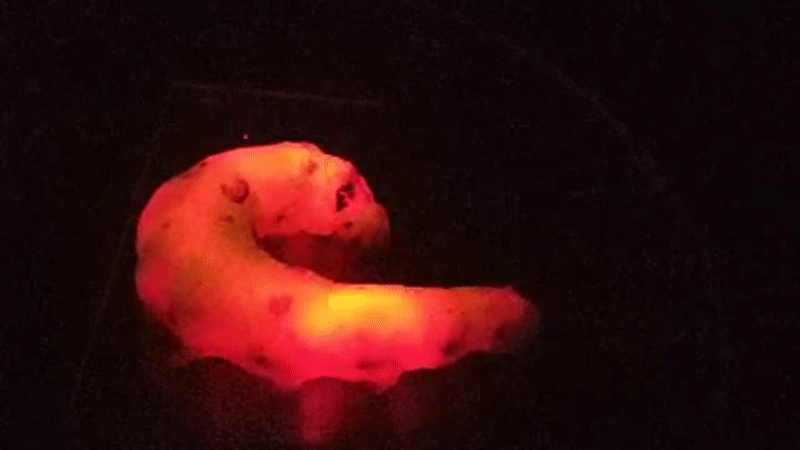Tiny, Solar-Powered Sensors Fly Through the Air Like Dandelion Seeds
The battery-free devices could be used to gather environmental data over long distances and provide insights into an ecosystem's health
Citizen Scientist Captures Glimpse of Jupiter's Moons, Io and Europa, Using Juno Space Probe Data
The natural satellites are seen in the distant background of the gas giant's portrait
First Global Atlas Reveals How Deep Artificial Light at Night Goes Underwater
Offshore development and coastal city lights negatively impact many marine species
1.4 Million Urban Trees May Fall to Invasive Insects by 2050
It could cost 30 million a year to replace infected trees in areas hardest hit by the non-native species
Scientists Are Using Sex Pheromones to Lure in Murder Hornets
The method may be the best way to eliminate the insects from non-native habitats
Octopuses Are Reusing Human Trash as Shelter
In crowdsourced images, the cephalopods were observed making refuse their home, even using the junk as a place to lay eggs
New Rainbow-Colored, Deep-Sea Fish Officially Described by Scientists in the Maldives
The new-to-science species was named after roses, the Maldivian national flower
A Penguin Faces Death by Leopard Seal in Jaw-Dropping Grand Prize Image
Winners in this year's World Nature Photography Awards were selected for 14 different categories varying by species and habitat
Science Twitter's 'InverteButt Week' Puts Backsides on Display
The behinds of spineless organisms are diverse among species and serve a multitude of purposes beyond expelling waste
Road Salt Pollution Levels Deemed Safe in U.S. and Canada May Not Protect Freshwater Ecosystems Enough
At current thresholds, salinization can kill off zooplankton, a crucial microorganism at the center of many food webs
Adopted Lone Narwhal Traveling Among Belugas Could Produce Narluga Calves
The mammal, now reaching sexual maturity, could mate soon, giving researchers more insight into the previously elusive hybrid animals
Silkworms Fed Quantum Dots Shine Bright Under Ultraviolet Light, Produce Fluorescent Red Silk
Caterpillars that ate carbon dots derived from mulberry leaves glowed a scarlet color that lasted until the second generation of worms
How Sanctions on Russia Affect International Space Programs
Roscosmos is severing ties with global partners in response to restrictions
Scientists Will Study the Effects of Microgravity on Skin at the International Space Station
The experiment, using engineered skin samples, could lead to better skin care products
Ukrainian Officials Say the World's Largest Aircraft, Antonov AN-225, Has Been Destroyed
The plane was undergoing maintenance in an airfield near Kyiv
To Protect Bighorn Sheep, Authorities Kill 58 Mountain Goats in Grand Teton National Park
The cull is part of an effort to safeguard the park's vulnerable sheep herd from the non-native species
Dogs May Mourn the Loss of Other Household Pets
Grieving canines ate less, slept more, and sought more attention from their human companions after the death of a furry friend, according to a survey
Hubble Space Telescope Captures Galaxies Caught in Triangular Tug-of-War
A collision between two galaxies may have sparked the odd shape
Sneaky Magpies Outwit Scientists by Removing Tracking Devices
The trackers were supposed to track movement behaviors but instead uncovered an unusual problem-solving behavior
Long-Term Space Travel May 'Rewire' Astronauts' Brains
The changes may help the organ adapt to microgravity, but they seem to persist for several months after returning to Earth
Page 5 of 19
/https://tf-cmsv2-smithsonianmag-media.s3.amazonaws.com/accounts/headshot/gamillo007710829-005_0.png)
:focal(750x500:751x501)/https://tf-cmsv2-smithsonianmag-media.s3.amazonaws.com/filer_public/c4/66/c466e7f3-d7ea-4fa9-b2d9-c2a231fc0f5b/dandelionsensorsweb002.jpg)
:focal(492x324:493x325)/https://tf-cmsv2-smithsonianmag-media.s3.amazonaws.com/filer_public/38/bc/38bcde0b-1140-4576-93c4-de6887f8fad6/junocam_jupiter_moons_figureb.jpeg)
:focal(360x273:361x274)/https://tf-cmsv2-smithsonianmag-media.s3.amazonaws.com/filer_public/c6/73/c673220b-7c8d-4e10-9052-3e929bfa2199/persiangulf_alan_12.jpg)
:focal(519x395:520x396)/https://tf-cmsv2-smithsonianmag-media.s3.amazonaws.com/filer_public/c6/4a/c64aef8c-abda-42d8-8531-165b7a48e62d/5549968-smpt-e1647000462620.jpg)
:focal(1524x670:1525x671)/https://tf-cmsv2-smithsonianmag-media.s3.amazonaws.com/filer_public/ad/64/ad6407bf-f721-4322-be27-66792d0d32f1/male_vespa_mandariniadsc_1515.jpg)
:focal(643x379:644x380)/https://tf-cmsv2-smithsonianmag-media.s3.amazonaws.com/filer_public/3d/fe/3dfe5b7a-ff2d-46ad-80d7-be2f31676d19/one_mans_trash.jpg)
:focal(302x242:303x243)/https://tf-cmsv2-smithsonianmag-media.s3.amazonaws.com/filer_public/86/55/8655aa08-f7b8-4f0a-a66c-7331c2634044/cirrhilabrus_finifenmaa_release_1.jpeg)
:focal(704x439:705x440)/https://tf-cmsv2-smithsonianmag-media.s3.amazonaws.com/filer_public/1c/6b/1c6b8dc3-9b01-44ed-841f-5e3d196e10c2/facingreality_leopardseal__penguin.jpeg)
:focal(1134x857:1135x858)/https://tf-cmsv2-smithsonianmag-media.s3.amazonaws.com/filer_public/ea/af/eaaf54ad-c558-47e6-b5ce-ecc5290637e9/41694106690_4d8b53e579_o.jpg)
:focal(3127x2085:3128x2086)/https://tf-cmsv2-smithsonianmag-media.s3.amazonaws.com/filer_public/a5/ea/a5ea5d77-ff7f-4572-a84b-294a2fa44a63/gettyimages-1098394810.jpg)
:focal(1120x417:1121x418)/https://tf-cmsv2-smithsonianmag-media.s3.amazonaws.com/filer_public/8d/37/8d3788e6-8698-4421-94e7-e404b6241aa1/screen_shot_2022-03-08_at_113907_am.png)

:focal(516x327:517x328)/https://tf-cmsv2-smithsonianmag-media.s3.amazonaws.com/filer_public/2b/c5/2bc53332-50e5-443f-8c6b-5e2097213b99/iss066e080193.jpg)
:focal(800x533:801x534)/https://tf-cmsv2-smithsonianmag-media.s3.amazonaws.com/filer_public/40/c7/40c7c7ce-aa57-49ce-bff3-4d5dff430b75/1600px-international_space_station.jpg)
:focal(1782x696:1783x697)/https://tf-cmsv2-smithsonianmag-media.s3.amazonaws.com/filer_public/0c/c3/0cc3ba07-42b5-482a-83e7-74b1bd17974c/antonov_an-225.jpg)
:focal(1331x900:1332x901)/https://tf-cmsv2-smithsonianmag-media.s3.amazonaws.com/filer_public/44/f5/44f502b6-6bc0-4ffe-8e3e-8840b56f8b63/mountain_goat_usfws-1.jpg)
:focal(1770x1180:1771x1181)/https://tf-cmsv2-smithsonianmag-media.s3.amazonaws.com/filer_public/a9/8b/a98bdc38-d2b2-449d-a05a-f45828fda37e/sad_dog.jpg)
:focal(2472x1227:2473x1228)/https://tf-cmsv2-smithsonianmag-media.s3.amazonaws.com/filer_public/24/98/24986b19-be0d-44c2-a4da-4162a0076481/stsci-01fvyyaynmmdak0yepkx2fjerv.jpeg)
:focal(800x350:801x351)/https://tf-cmsv2-smithsonianmag-media.s3.amazonaws.com/filer_public/e8/68/e868cca6-a04c-4a19-9c0e-9800683aabca/australian_magpie_feeding.jpg)
:focal(960x960:961x961)/https://tf-cmsv2-smithsonianmag-media.s3.amazonaws.com/filer_public/5a/e8/5ae8e0c3-dbdc-40c2-92be-470ce1e2306e/1920px-bruce_mccandless_ii_during_eva_in_1984.jpg)